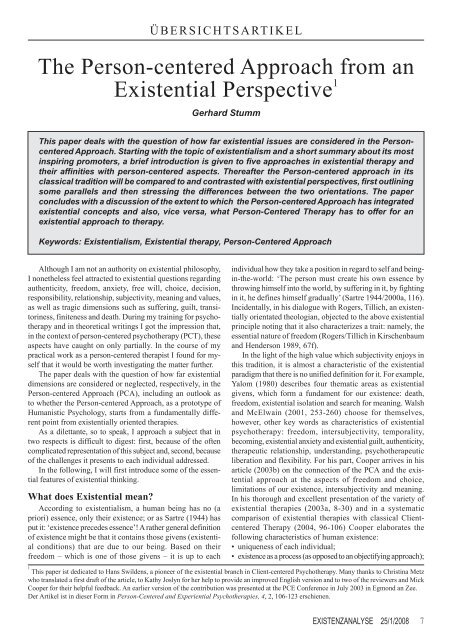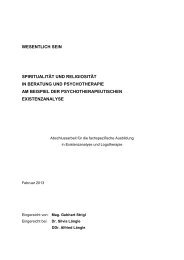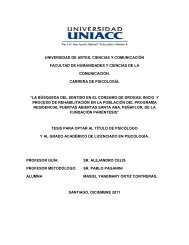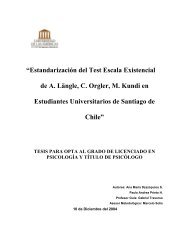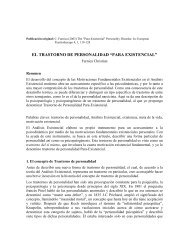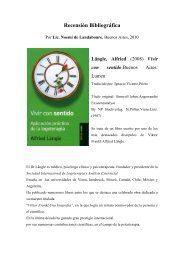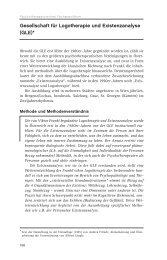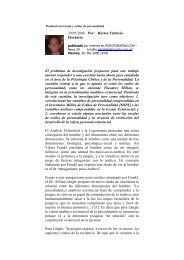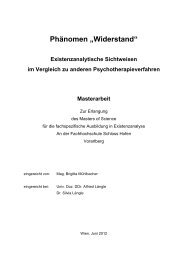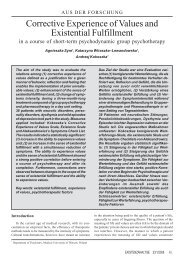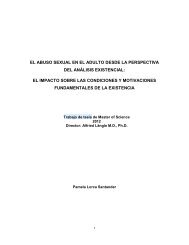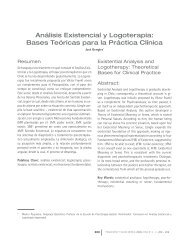The Person-centered Approach from an Existential ... - Home
The Person-centered Approach from an Existential ... - Home
The Person-centered Approach from an Existential ... - Home
Create successful ePaper yourself
Turn your PDF publications into a flip-book with our unique Google optimized e-Paper software.
ÜBERSICHTSARTIKEL<br />
<strong>The</strong> <strong>Person</strong>-<strong>centered</strong> <strong>Approach</strong> <strong>from</strong> <strong>an</strong><br />
<strong>Existential</strong> Perspective 1<br />
Gerhard Stumm<br />
This paper deals with the question of how far existential issues are considered in the <strong>Person</strong><strong>centered</strong><br />
<strong>Approach</strong>. Starting with the topic of existentialism <strong>an</strong>d a short summary about its most<br />
inspiring promoters, a brief introduction is given to five approaches in existential therapy <strong>an</strong>d<br />
their affinities with person-<strong>centered</strong> aspects. <strong>The</strong>reafter the <strong>Person</strong>-<strong>centered</strong> approach in its<br />
classical tradition will be compared to <strong>an</strong>d contrasted with existential perspectives, first outlining<br />
some parallels <strong>an</strong>d then stressing the differences between the two orientations. <strong>The</strong> paper<br />
concludes with a discussion of the extent to which the <strong>Person</strong>-<strong>centered</strong> <strong>Approach</strong> has integrated<br />
existential concepts <strong>an</strong>d also, vice versa, what <strong>Person</strong>-Centered <strong>The</strong>rapy has to offer for <strong>an</strong><br />
existential approach to therapy.<br />
Keywords: <strong>Existential</strong>ism, <strong>Existential</strong> therapy, <strong>Person</strong>-Centered <strong>Approach</strong><br />
Although I am not <strong>an</strong> authority on existential philosophy,<br />
I nonetheless feel attracted to existential questions regarding<br />
authenticity, freedom, <strong>an</strong>xiety, free will, choice, decision,<br />
responsibility, relationship, subjectivity, me<strong>an</strong>ing <strong>an</strong>d values,<br />
as well as tragic dimensions such as suffering, guilt, tr<strong>an</strong>sitoriness,<br />
finiteness <strong>an</strong>d death. During my training for psychotherapy<br />
<strong>an</strong>d in theoretical writings I got the impression that,<br />
in the context of person-<strong>centered</strong> psychotherapy (PCT), these<br />
aspects have caught on only partially. In the course of my<br />
practical work as a person-<strong>centered</strong> therapist I found for myself<br />
that it would be worth investigating the matter further.<br />
<strong>The</strong> paper deals with the question of how far existential<br />
dimensions are considered or neglected, respectively, in the<br />
<strong>Person</strong>-<strong>centered</strong> <strong>Approach</strong> (PCA), including <strong>an</strong> outlook as<br />
to whether the <strong>Person</strong>-<strong>centered</strong> <strong>Approach</strong>, as a prototype of<br />
Hum<strong>an</strong>istic Psychology, starts <strong>from</strong> a fundamentally different<br />
point <strong>from</strong> existentially oriented therapies.<br />
As a dilett<strong>an</strong>te, so to speak, I approach a subject that in<br />
two respects is difficult to digest: first, because of the often<br />
complicated representation of this subject <strong>an</strong>d, second, because<br />
of the challenges it presents to each individual addressed.<br />
In the following, I will first introduce some of the essential<br />
features of existential thinking.<br />
What does <strong>Existential</strong> me<strong>an</strong>?<br />
According to existentialism, a hum<strong>an</strong> being has no (a<br />
priori) essence, only their existence; or as Sartre (1944) has<br />
put it: ‘existence precedes essence’! A rather general definition<br />
of existence might be that it contains those givens (existential<br />
conditions) that are due to our being. Based on their<br />
freedom – which is one of those givens – it is up to each<br />
individual how they take a position in regard to self <strong>an</strong>d beingin-the-world:<br />
‘<strong>The</strong> person must create his own essence by<br />
throwing himself into the world, by suffering in it, by fighting<br />
in it, he defines himself gradually’ (Sartre 1944/2000a, 116).<br />
Incidentally, in his dialogue with Rogers, Tillich, <strong>an</strong> existentially<br />
orientated theologi<strong>an</strong>, objected to the above existential<br />
principle noting that it also characterizes a trait: namely, the<br />
essential nature of freedom (Rogers/Tillich in Kirschenbaum<br />
<strong>an</strong>d Henderson 1989, 67f).<br />
In the light of the high value which subjectivity enjoys in<br />
this tradition, it is almost a characteristic of the existential<br />
paradigm that there is no unified definition for it. For example,<br />
Yalom (1980) describes four thematic areas as existential<br />
givens, which form a fundament for our existence: death,<br />
freedom, existential isolation <strong>an</strong>d search for me<strong>an</strong>ing. Walsh<br />
<strong>an</strong>d McElwain (2001, 253-260) choose for themselves,<br />
however, other key words as characteristics of existential<br />
psychotherapy: freedom, intersubjectivity, temporality,<br />
becoming, existential <strong>an</strong>xiety <strong>an</strong>d existential guilt, authenticity,<br />
therapeutic relationship, underst<strong>an</strong>ding, psychotherapeutic<br />
liberation <strong>an</strong>d flexibility. For his part, Cooper arrives in his<br />
article (2003b) on the connection of the PCA <strong>an</strong>d the existential<br />
approach at the aspects of freedom <strong>an</strong>d choice,<br />
limitations of our existence, intersubjectivity <strong>an</strong>d me<strong>an</strong>ing.<br />
In his thorough <strong>an</strong>d excellent presentation of the variety of<br />
existential therapies (2003a, 8-30) <strong>an</strong>d in a systematic<br />
comparison of existential therapies with classical Client<strong>centered</strong><br />
<strong>The</strong>rapy (2004, 96-106) Cooper elaborates the<br />
following characteristics of hum<strong>an</strong> existence:<br />
• uniqueness of each individual;<br />
• existence as a process (as opposed to <strong>an</strong> objectifying approach);<br />
1<br />
This paper ist dedicated to H<strong>an</strong>s Swildens, a pioneer of the existential br<strong>an</strong>ch in Client-<strong>centered</strong> Psychotherapy. M<strong>an</strong>y th<strong>an</strong>ks to Christina Metz<br />
who tr<strong>an</strong>slated a first draft of the article, to Kathy Joslyn for her help to provide <strong>an</strong> improved English version <strong>an</strong>d to two of the reviewers <strong>an</strong>d Mick<br />
Cooper for their helpful feedback. An earlier version of the contribution was presented at the PCE Conference in July 2003 in Egmond <strong>an</strong> Zee.<br />
Der Artikel ist in dieser Form in <strong>Person</strong>-Centered <strong>an</strong>d Experiential Psychotherapies, 4, 2, 106-123 erschienen.<br />
EXISTENZANALYSE 25/1/2008 7
• existence as being fundamentally free (within given limits<br />
such as the context into which we are born, time, death);<br />
• <strong>an</strong> orientation towards future (motivation through goals,<br />
intention <strong>an</strong>d me<strong>an</strong>ing);<br />
• existence as being-in-the-world (emphasizing our inseparable<br />
connectedness with our environment);<br />
• being with others (accentuating the insoluble interrelatedness<br />
with others);<br />
• the embodiedness of our being;<br />
• tragic dimensions including existential <strong>an</strong>xiety <strong>an</strong>d guilt;<br />
• the challenge of living authentically as <strong>an</strong> existential task;<br />
<strong>an</strong>d<br />
• as a basis of a phenomenological st<strong>an</strong>ce.<br />
<strong>The</strong> me<strong>an</strong>ing of ‘existential’ c<strong>an</strong> perhaps best be illustrated<br />
with a practical example: the incarnate situation of uncertainty,<br />
that ‘being-thrown-back-upon-oneself’ while waiting for the<br />
results of medical testing with far-reaching consequences such<br />
as, for example, the results of <strong>an</strong> AIDS test. In such a ‘limitsituation’<br />
(to use Jaspers’ phrase) a hum<strong>an</strong> being is most likely<br />
living in immediate experience <strong>an</strong>d threatened as a whole by<br />
what is about to come in the future (above all by the final limit,<br />
their death); but, at the same time, is free to st<strong>an</strong>d up against<br />
it, facing authentically what it me<strong>an</strong>s to them, <strong>an</strong>d also in relation<br />
to others. Of course one c<strong>an</strong> deny the outst<strong>an</strong>ding quality of<br />
such <strong>an</strong> extreme experience, but in existential terms this would<br />
me<strong>an</strong> choosing not to be involved in existential concerns.<br />
Though existential issues are as old as m<strong>an</strong>kind, the history<br />
of existential philosophy in a narrower sense is a relatively<br />
young one, representing a complete departure <strong>from</strong> classical<br />
philosophy. In the following section I will briefly introduce<br />
the most prominent protagonists of existential philosophy,<br />
with the key themes <strong>an</strong>d guiding ideas that are also relev<strong>an</strong>t<br />
for <strong>an</strong>d <strong>from</strong> a person-<strong>centered</strong> view.<br />
On the historical background <strong>an</strong>d the roots of<br />
<strong>Existential</strong> Psychotherapy<br />
<strong>The</strong> most import<strong>an</strong>t proponents of existential philosophy<br />
were, among others, Kierkegaard (1813-1855), Heidegger<br />
(1889-1976), Jaspers (1883-1969), Sartre (1905-1980), <strong>an</strong>d<br />
Buber (1878-1965) (Zimmerm<strong>an</strong>n 1976). Yalom also mentions<br />
these thinkers <strong>an</strong>d labels existentialism in regard to existential<br />
psychotherapy as ‘<strong>Home</strong> of the Ancestors’ (1980/1989, 26).<br />
With Kierkegaard the themes of freedom <strong>an</strong>d <strong>an</strong>xiety<br />
(dread) as well as authenticity are primarily addressed. ‘Freud<br />
... knew about <strong>an</strong>xiety, ... Kierkegaard ... knew <strong>an</strong>xiety“ (May<br />
1969, 3).<br />
<strong>The</strong> question of freedom was also of the utmost signific<strong>an</strong>ce<br />
for Sartre. He was even of the opinion that we are<br />
‘damned to freedom’; his concept of freedom leads towards<br />
the freedom ‘to’ something <strong>an</strong>d not the freedom ‘<strong>from</strong>’<br />
something, a thought which was also emphasized by Fromm<br />
<strong>an</strong>d Fr<strong>an</strong>kl, the founder of logotherapy (see also the following<br />
chapter on existential therapies).<br />
Buber especially – also in a psychotherapeutic context –<br />
became famous for his concept of the ‘I-Thou-encounter’<br />
8<br />
EXISTENZANALYSE 25/1/2008<br />
ÜBERSICHTSARTIKEL<br />
(1923/1958). His emphasis on polarity <strong>an</strong>d (sometimes tragic)<br />
limits (facticity) plays a role in our topic here.<br />
Heidegger (first of all 1927) presented numerous concepts<br />
that in this context are of import<strong>an</strong>ce, such as, essentiality<br />
(„Eigentlichkeit“) vs. non-essentiality (‘one’) („m<strong>an</strong>“) as<br />
modes of being (that is, authentic/existential mode of being<br />
vs. every day mode of being). Also his comparison of types of<br />
caring for someone else („Fürsorge“) is highly signific<strong>an</strong>t for<br />
person-<strong>centered</strong> psychotherapy. While ’leaping in’ takes over<br />
the responsibility of the other, ‘leaping ahead’ on the other<br />
h<strong>an</strong>d facilitates self-exploration of the other in order that he/<br />
she finds his/her own direction.<br />
Jaspers defined existential illumination as a concept of<br />
possibilities for a fulfilling existence <strong>an</strong>d ‘existential choice’ as<br />
active decision making (Jaspers 1935). He classified the<br />
confrontation with illness, death, emptiness <strong>an</strong>d existential<br />
<strong>an</strong>xiety as ‘Boundary Situations’ (i.e., the loss of a loved one,<br />
the collapse of a self-concept or a concept of me<strong>an</strong>ingfulness,<br />
<strong>an</strong> irreversible decision), which allow people to get in authentic<br />
touch with themselves.<br />
Let it be noted that at the beginning of his career as<br />
counsellor <strong>an</strong>d therapist Rogers was not familiar with the<br />
existential thinkers. Only after his students pointed out that<br />
they had found some parallels in his approach did he seriously<br />
take up existential philosophy. As a consequence, he refers<br />
repeatedly (e.g., 1961a) to Kierkegaard (speaking for inst<strong>an</strong>ce<br />
of the ‘true self’ in the sense of authenticity, but also with<br />
his references to freedom <strong>an</strong>d <strong>an</strong>xiety) - <strong>an</strong>d to Buber<br />
(primarily his concept of encounter); <strong>an</strong>d sporadically to<br />
Sartre. That he did not quote Heidegger <strong>an</strong>d Jaspers, is, in<br />
my opinion, due to the fact that their writings, at the time<br />
Rogers was busy with existential philosophical texts, were<br />
in part not yet tr<strong>an</strong>slated (Heidegger’s main work Being <strong>an</strong>d<br />
Time, for example, originally published in 1927, was first<br />
tr<strong>an</strong>slated into English in 1964). Shlien (1997, 69f) shows<br />
how interested Rogers was around 1950 in Buber’s books, I<br />
<strong>an</strong>d Thou <strong>an</strong>d Between M<strong>an</strong> <strong>an</strong>d M<strong>an</strong>. (Shlien further<br />
commented that, ‘Buber was far ahead of us’ (ibid., 70).<br />
One may also assume that Rogers, in his pragmatic way <strong>an</strong>d<br />
with his experience-relev<strong>an</strong>t theorizing, would not have<br />
enjoyed Heidegger’s highly complicated l<strong>an</strong>guage.<br />
Anyway, Rogers <strong>an</strong>d some of his associates, for inst<strong>an</strong>ce<br />
Gendlin (1966; 1975), Braaten (1961) <strong>an</strong>d Prouty (2002, with<br />
his reference to Leslie Farber), drew much <strong>from</strong> the<br />
existentialistic wave that entered the Americ<strong>an</strong> scene. I shall<br />
return to Rogers’ references to existential perspectives in<br />
later sections on the parallels <strong>an</strong>d the differences of the two<br />
paradigms.<br />
<strong>Existential</strong> Psychotherapy<br />
‘<strong>Existential</strong> Psychotherapy’ is not a unified school of<br />
psychotherapy. To a much greater extent, it represents a<br />
paradigmatic trend in psychotherapy with diverse examples<br />
<strong>an</strong>d varieties (Yalom 1980; Cain 2001, 22-29; Cooper 2003a;<br />
2004).<br />
Cooper (2003a; 2004) distinguishes five main streams in
existential therapy: Daseins<strong>an</strong>alysis, Logotherapy, <strong>The</strong> existential-hum<strong>an</strong>istic<br />
approach, Laing’s approach <strong>an</strong>d the British<br />
school of existential <strong>an</strong>alysis. In both publications, he<br />
<strong>an</strong>alysizes the signific<strong>an</strong>t characteristics of these five<br />
approaches. In the second one he compares each of them<br />
systematically with the main concepts of the <strong>Person</strong>-Centered<br />
<strong>Approach</strong>. To be brief, I will restrict myself to a condensed<br />
illustration of the five forms of existential therapy, extracting<br />
a few conclusions <strong>from</strong> Cooper in regard to a comparison<br />
with PCA, <strong>an</strong>d will also add some aspects.<br />
Daseins<strong>an</strong>alysis<br />
This br<strong>an</strong>ch of existential therapies has been developed<br />
by Binsw<strong>an</strong>ger, Boss <strong>an</strong>d others such as G. Condrau, drawing<br />
m<strong>an</strong>y elements <strong>from</strong> the work of Heidegger, for inst<strong>an</strong>ce a<br />
strong emphasis on openness to the world. With Cooper (2004,<br />
108-109) I share the view that Rogers (e.g., 1961a), too, in<br />
his conception of the process-continuum of personal development<br />
classifies openness for experiences as <strong>an</strong> indicator of a<br />
mature <strong>an</strong>d functioning person. Cooper, however, refers to a<br />
subtle difference between the two schools of thought: while<br />
PCA focuses on ‘inner’ experiences, stressing selfrelatedness,<br />
Daseins<strong>an</strong>alysis lays emphasis on the person’s<br />
relatedness to the world.<br />
Logotherapy <strong>an</strong>d <strong>Existential</strong> Analysis<br />
Originating in the work of Viktor Fr<strong>an</strong>kl, the classical<br />
approach is clearly me<strong>an</strong>ing-<strong>centered</strong>. For Fr<strong>an</strong>kl it is the<br />
striving for me<strong>an</strong>ing which is the core motive of hum<strong>an</strong><br />
beings. That concept shows a clear distinction <strong>from</strong> PCA,<br />
because Fr<strong>an</strong>kl assumes a preference in the motivation of<br />
hum<strong>an</strong> beings that is not the case in the concept of the<br />
actualizing tendency. I agree with Cooper that the original<br />
version of logotherapy, which is still communicated in<br />
trainings <strong>an</strong>d in literature (e.g., Lukas 2002), applies a much<br />
more directive attitude th<strong>an</strong> PCT.<br />
Apart <strong>from</strong> the classical br<strong>an</strong>ch, however, a second<br />
school inspired by Alfried Längle (2000), has been<br />
established within the existential <strong>an</strong>alytical community. By<br />
adding ‘one’s relation to the world’, ‘one’s relation to life’<br />
<strong>an</strong>d ‘one’s relation to oneself’, he arrives at four fundamental<br />
motivational forces, thereby lessening signific<strong>an</strong>tly<br />
the crucial role of me<strong>an</strong>ing as the main motivational force<br />
in hum<strong>an</strong> beings (Längle 2002). Fr<strong>an</strong>kl himself thought<br />
this to be ‘<strong>Person</strong>-<strong>centered</strong> therapy at its best’ (Stumm<br />
2000), as it places ‘self-accept<strong>an</strong>ce’ as a third pillar of<br />
hum<strong>an</strong> capacities – ‘<strong>an</strong>thropological implications’ – besides<br />
‘self-dist<strong>an</strong>cing’ <strong>an</strong>d ‘self-tr<strong>an</strong>scendence’ in the theoretical<br />
framework of existential <strong>an</strong>alysis. As a result, Fr<strong>an</strong>kl left<br />
his own logotherapeutic org<strong>an</strong>ization. For him the introduction<br />
of the self via self-accept<strong>an</strong>ce <strong>an</strong>d self-experience<br />
was a break with his me<strong>an</strong>ing-orientated outlook. Though<br />
this new trend in existential <strong>an</strong>alysis is certainly less<br />
authoritari<strong>an</strong> in practice, I doubt that it really tends to be<br />
non-directive, as it includes both a lot of systematic techniques<br />
<strong>an</strong>d holds that the therapist must be a challenger<br />
for his clients.<br />
ÜBERSICHTSARTIKEL<br />
<strong>The</strong> Laingi<strong>an</strong> approach<br />
Though this specific conception has a strict phenomenological<br />
<strong>an</strong>d interpersonal profile, the similarities to PCT, at<br />
least in my view, are rather superficial. Neither in theory nor<br />
in practice do the two approaches have remarkable attributes<br />
in common. Disregarding that Laing obviously detested Rogers<br />
(Cooper 2004, 115; see also the Rogers-Laing meeting in<br />
1978, reported by Maureen O’Hara, 1995, 118-127), it seems<br />
to me that Laing’s often rude tone reveals a lack of fundamental<br />
positive regard towards others. Further, although<br />
perhaps just a detail, the fact that he is said to have ‘often’<br />
gone ‘through whole sessions without saying a word’ (Cooper<br />
2004, 117) is not to me convincing proof for receptivity <strong>an</strong>d a<br />
non-directive involvement. Though it might imply accurate<br />
listening, <strong>from</strong> a person-<strong>centered</strong> st<strong>an</strong>dpoint it does lack<br />
communicating of empathic underst<strong>an</strong>ding <strong>an</strong>d positive regard.<br />
<strong>The</strong> British school of existential <strong>an</strong>alysis<br />
Initiated <strong>an</strong>d especially inspired by Emmy v<strong>an</strong> Deurzen,<br />
this approach emphasizes everyday life challenges <strong>an</strong>d<br />
philosophical dialogue in therapy. It shows – even more so in<br />
the writings of Spinelli who employs a type of client-oriented<br />
attitude – some affinities with the <strong>Person</strong>-Centered <strong>Approach</strong>,<br />
e.g., a depathologizing st<strong>an</strong>ce that values the subjective world<br />
of the client (see V<strong>an</strong> Deurzen 2001).<br />
<strong>The</strong> existential-hum<strong>an</strong>istic approach<br />
Represented <strong>an</strong>d advocated above all by Rollo May<br />
(Schneider 2005) <strong>an</strong>d others such as Bugental (deCarvalho<br />
2005), Yalom (1980/1989) <strong>an</strong>d Schneider (1998), it grew<br />
out of the hum<strong>an</strong>istic movement (see also the following<br />
section on the comparison of the person-<strong>centered</strong> <strong>an</strong>d existential<br />
paradigm). Widely spread in the USA, it has<br />
emphasized client subjective experiences <strong>an</strong>d therapist<br />
authenticity, including the external side of the latter, the<br />
therapist’s fr<strong>an</strong>kness <strong>an</strong>d self-revelation. While this shows<br />
a distinct affinity to PCT, existential-hum<strong>an</strong>istic therapists<br />
not only rely on the trustworthiness of hum<strong>an</strong> nature <strong>an</strong>d<br />
org<strong>an</strong>ismic self-regulation but challenge their clients to focus<br />
on specific issues <strong>an</strong>d defenses (see also Rogers’ dialogue<br />
with May: Rogers 1981, 1982; May 1982). In m<strong>an</strong>y respects<br />
this br<strong>an</strong>d of existential therapy is closely related to explicit<br />
hum<strong>an</strong>istic ideas <strong>an</strong>d views. Yalom therefore expressed the<br />
existential viewpoint when he coined the term ‘optimistic<br />
neighbors’ to refer to the North Americ<strong>an</strong> advocates of<br />
Hum<strong>an</strong>istic Psychology (see Table 1).<br />
In the following section I compare existential therapies <strong>an</strong>d<br />
the classical <strong>Person</strong>-Centered <strong>Approach</strong> in therapy in a more<br />
systematic way. It should be evident that despite its interest in<br />
existential concerns, PCA is rooted more in conceptions<br />
originating in <strong>an</strong>d associated with Hum<strong>an</strong>istic Psychology.<br />
Schematic categories <strong>an</strong>d tables naturally oversimplify the<br />
diversity <strong>an</strong>d complexity of the subject being represented <strong>an</strong>d<br />
may suggest entities that – regarding differentiation <strong>an</strong>d genuineness<br />
of the various streams <strong>an</strong>d persons – do not exist in<br />
reality. <strong>The</strong> reader must underst<strong>an</strong>d that only for didactic reasons<br />
have I chosen to present the material in such a formal way.<br />
EXISTENZANALYSE 25/1/2008 9
<strong>Existential</strong><br />
Oriented<br />
Analysts<br />
10<br />
Europe<strong>an</strong> Tradition<br />
Daseins<strong>an</strong>alysis Logotherapy/<br />
<strong>Existential</strong><br />
Analysis<br />
<strong>The</strong> person-<strong>centered</strong> approach <strong>an</strong>d <strong>Existential</strong><br />
Psychology<br />
I will now present my comparison of the two paradigms,<br />
first highlighting parallels, similiarities <strong>an</strong>d commonalities between<br />
PCA <strong>an</strong>d existential therapies. In a second step the two models<br />
will be contrasted by illustrating the differences (see Table 2)<br />
<strong>an</strong>d commenting on each of the oppositions. Of course, a strict<br />
separation of commonalities <strong>an</strong>d differences is <strong>an</strong> artificial<br />
venture; again, for didactic reasons, it might be tolerated.<br />
<strong>Existential</strong> aspects in the classical <strong>Person</strong>-<br />
Centered <strong>Approach</strong><br />
Since its foundation, PCA has experienced modifications<br />
<strong>an</strong>d expressions that show existential inspiration. Starting with<br />
Rogers himself, Gendlin, Prouty <strong>an</strong>d m<strong>an</strong>y others – such as<br />
v<strong>an</strong> Kalmthout, Lietaer, Zurhorst <strong>an</strong>d, above all, Swildens whose<br />
‘Process Oriented Client-Centered Psychotherapy’ (1988/1991;<br />
2002) is based on Heidegger’s existential philosophy – have<br />
been concerned with existential philosophy. Limiting myself<br />
in this paper I will refer only to Rogers.<br />
Phenomenology, the frame of reference <strong>an</strong>d uniqueness of<br />
the client<br />
First of all, Rogers takes a radical phenomenological<br />
st<strong>an</strong>ce, attempting to encounter his clients with no preconceptions,<br />
following their track <strong>an</strong>d catching their inner<br />
experiencing. To me, Rogers supersedes in this respect m<strong>an</strong>y<br />
of the existential therapists who are often preoccupied with<br />
their frame of reference (for example, that clients should be<br />
worried about certain ‘ultimate concerns’), though they claim<br />
phenomenology as indispensable fundament of <strong>an</strong> existential<br />
attitude. Rogers had great respect for subjectivity, the client’s<br />
inner frame of reference as his/her phenomenal field <strong>an</strong>d for<br />
his uniqueness; in Rogers’ early phase he particularly<br />
emphasized being careful not to introduce external frames of<br />
reference onto the client.<br />
Client’s ability for awareness <strong>an</strong>d the experiencing individual<br />
Rogers was totally convinced of the fundamental ability<br />
of the client for awareness, to evaluate <strong>an</strong>d solve their own<br />
problems, as long as favorable intersubjective conditions were<br />
available. As in existential theory, there is no assumption of<br />
<strong>an</strong> unconscious as <strong>an</strong> agent; instead, we go through proces-<br />
EXISTENZANALYSE 25/1/2008<br />
ÜBERSICHTSARTIKEL<br />
British<br />
School of<br />
<strong>Existential</strong><br />
Analysis<br />
Americ<strong>an</strong><br />
<strong>Existential</strong><br />
Hum<strong>an</strong>istic<br />
<strong>Approach</strong><br />
Hum<strong>an</strong>istic<br />
Psychologists<br />
(as ‘Optimistic<br />
Americ<strong>an</strong><br />
Neighbors’)<br />
Hum<strong>an</strong>istic<br />
Analysts<br />
(as ‘Friends<br />
of the<br />
Family’)<br />
Gebsattel Binsw<strong>an</strong>ger Fr<strong>an</strong>kl Laing v<strong>an</strong> Deurzen May Goldstein Adler<br />
Caruso Boss Längle Spinelli Bugental Maslow R<strong>an</strong>k<br />
Condrau H. Cohn Yalom Bühler Horney<br />
Schneider Rogers Fromm<br />
Perls Kohut<br />
Tab. 1: Family Tree of <strong>Existential</strong> Psychotherapy <strong>an</strong>d its Proponents (adapted <strong>from</strong> Irvin Yalom, 1980 <strong>an</strong>d Cooper 2003a; 2004)<br />
ses that we are not (fully) aware of. According to both Rogers<br />
<strong>an</strong>d the existentialists, we are capable of becoming aware of<br />
the relev<strong>an</strong>t psychological processes that determine our being<br />
in the world. Experiences are appreciated as tools to help us<br />
adjust to our environment <strong>an</strong>d in life; for Rogers they are the<br />
highest authority.<br />
‘Being with’ <strong>an</strong>d autonomy<br />
As I previously noted, Rogers emphasized the necessity<br />
of the therapist providing specific attitudes within the<br />
therapeutic relationship. Rogers referred to this as ‘a way of<br />
being with persons’ (Rogers 1980), <strong>an</strong>d he saw the individual<br />
as ‘uncurably social’ <strong>an</strong>d a ‘social <strong>an</strong>imal’ (1961b). This is<br />
reminiscent of Heidegger’s ‘Being-with’ <strong>an</strong>d the ideal that<br />
hum<strong>an</strong>s are interconnected with others as one of our existential<br />
givens. Though ‘being with others’, for existential<br />
philosophy, belongs to the ‘conditio hum<strong>an</strong>a’, it seems that<br />
existential therapy tries to bal<strong>an</strong>ce the polarities of being for<br />
oneself <strong>an</strong>d being with others. Rogers, too, moves between<br />
the two poles of a continuum: on one side, he affirmed, above<br />
all, the need for positive regard through others. But Rogers<br />
also advocated autonomy as a criterion for a mature person,<br />
hence moderating the import<strong>an</strong>ce of interpersonal dependency.<br />
<strong>The</strong> last example, again, reminds us that parallels, as well<br />
as sharp distinctions, should be regarded with caution. As I<br />
stated above they are inclined to oversimplification.<br />
Process character of the self<br />
In PCA the self is not <strong>an</strong> agent or <strong>an</strong> item within the<br />
person, but a phenomenologically derived concept: that is,<br />
how the person regards him- or herself. As such the self<br />
const<strong>an</strong>tly ch<strong>an</strong>ges, <strong>an</strong>d it ch<strong>an</strong>ges more as a person integrates<br />
new self-experiences. In this way, as Art Bohart (1991, 44)<br />
has stated, the self is more a ‘river’ th<strong>an</strong> a ‘house’. This is<br />
also valid for the ‘org<strong>an</strong>ismic self’, a term Rogers often used<br />
to designate a flexible ‘gestalt’ of the self that is congruent<br />
with the org<strong>an</strong>ism as a whole. That corresponds with the<br />
existential view, in which the process character of the self<br />
dominates <strong>an</strong>d in which a reification of the self is rejected.<br />
Reservation against static labeling<br />
At least with some approaches in existential therapy (above<br />
all the British school), the classical PCT shares its reservation<br />
about pathologizing categorizations.
Authenticity<br />
Probably one of the strongest commonalities of the two<br />
orientations is the stress on authenticity (congruence,<br />
genuineness), <strong>an</strong>d also the therapist’s non-abstinent but tr<strong>an</strong>sparent<br />
part in the therapeutic relationship. For Rogers<br />
authenticity is the result of mature development <strong>an</strong>d belongs<br />
to his health concept (with the ‘fully functioning person’ as<br />
the idealized final stage). As it requires <strong>an</strong> ‘existential choice’<br />
<strong>an</strong>d courageous personal engagement, including the courage<br />
to be oneself, even more existential dimensions such as<br />
freedom <strong>an</strong>d existential <strong>an</strong>xiety come in.<br />
Freedom of the individual<br />
For Rogers, freedom certainly is a very import<strong>an</strong>t quality.<br />
Though coupled with (existential) <strong>an</strong>xiety, it c<strong>an</strong> be achieved<br />
during personal development (also measured on the process<br />
scale). <strong>The</strong> ‘fully functioning person’ would be free to choose<br />
whatever is good for the org<strong>an</strong>ism. <strong>The</strong> ‘good life’, however,<br />
is not for the faint-hearted, but rather is bound to excitement<br />
<strong>an</strong>d challenge (Rogers 1961a/1973, 195). <strong>The</strong> increasing<br />
openness to experience <strong>an</strong>d existential choice as person<strong>centered</strong><br />
criteria of the growth process make the individual<br />
more independent <strong>an</strong>d self-reli<strong>an</strong>t. <strong>The</strong> ‘experiential flow’<br />
going on in a highly congruent person, in my view, resembles<br />
Heidegger’s ‘openness to the world’ stressed in the Daseins<strong>an</strong>alytic<br />
approach.<br />
Cooper (2004, 98) stated a contrast between Rogers’ view<br />
<strong>an</strong>d <strong>an</strong> existential st<strong>an</strong>dpoint by noting that Rogers presents<br />
‘freedom as something that hum<strong>an</strong> beings c<strong>an</strong> attain’, while<br />
for existential approaches freedom is <strong>an</strong> existential given that<br />
is innate to our being. To summarize Rogers’ attitude towards<br />
the free will of people, two tracks are revealed in Rogers (1961a/<br />
1973, 192): He is a determinist <strong>an</strong>d <strong>an</strong> existentialist.<br />
Subjectivity in the research process<br />
According to <strong>an</strong> existential point of view, researchers<br />
resemble individuals as they create <strong>an</strong>d construe the world<br />
through their selection of the research subject, of the<br />
hypotheses to be checked, of the research designs being used,<br />
<strong>an</strong>d of the interpretations of the results. Arguing against a<br />
split between subject <strong>an</strong>d object, existential theory underlines<br />
that there is no such thing as <strong>an</strong> objective observation. <strong>The</strong><br />
researcher developing or deciding for a research design or<br />
doing observation is part of the world <strong>an</strong>d of the research<br />
process. Though Rogers did qu<strong>an</strong>titative studies <strong>an</strong>d tested<br />
his theories <strong>an</strong>d concepts by me<strong>an</strong>s of objective material,<br />
contributing to a view of him also as a positivist, he stressed<br />
the import<strong>an</strong>ce of subjectivity in the research process, <strong>an</strong>d<br />
advocated that in selecting specific topics <strong>an</strong>d using certain<br />
designs the researcher brings in their own values <strong>an</strong>d choices<br />
(Rogers 1969).<br />
Differences between PCA <strong>an</strong>d existential<br />
approaches<br />
<strong>The</strong> <strong>Person</strong>-Centered <strong>Approach</strong> has been labeled both as a<br />
prototype of the hum<strong>an</strong>istic paradigm (e.g. Cain 2001, 16;<br />
Quitm<strong>an</strong>n 1991; Hutterer 1998) <strong>an</strong>d as having a more or less<br />
ÜBERSICHTSARTIKEL<br />
strong affinity to existential philosophical positions. Thus, it<br />
seems appropriate to start this section with a short exploration<br />
of the relation between these two orientations.<br />
Some who attempt to systematize psychotherapy combine<br />
‘hum<strong>an</strong>istic’ <strong>an</strong>d ‘existential’ together, by placing two<br />
overlapping headings under one historically derived common<br />
roof. <strong>The</strong>re exists some proof that, at the beginning,<br />
Hum<strong>an</strong>istic Psychology in the USA ‘imported’ terminology<br />
<strong>an</strong>d <strong>an</strong> existential approach <strong>from</strong> Europe (primarily via the<br />
work of Rollo May; note also the partly enthusiastic review<br />
by Rogers 1959, of the book Existence, published in 1958<br />
by May, Angel <strong>an</strong>d Ellenberger); but gradually the<br />
differentiation between hum<strong>an</strong>istic <strong>an</strong>d existential crystallized.<br />
<strong>The</strong> ‘Americ<strong>an</strong> existential-hum<strong>an</strong>istic approach’ (Cooper<br />
2003a, chapter 5; see also the previous sections including<br />
Table 1) could be regarded as a link between the two paradigms.<br />
However, some others – myself included – argue <strong>from</strong><br />
today’s perspective for a stronger differentiation between<br />
these orientations. Although in gestalt therapy (for inst<strong>an</strong>ce<br />
the concepts of self-responsibility, contact, <strong>an</strong>d the creative<br />
experiment in the here <strong>an</strong>d now), as well as in the <strong>Person</strong>-<br />
Centered <strong>Approach</strong>, <strong>an</strong> existential emphasis c<strong>an</strong> clearly be<br />
found, it is my opinion that a list of differing emphases on<br />
central aspects justifies this differentiation. I will now turn<br />
to these differences as they become visible in a comparison<br />
of existential therapy <strong>an</strong>d the <strong>Person</strong>-Centered <strong>Approach</strong> as<br />
a br<strong>an</strong>ch of Hum<strong>an</strong>istic Psychology.<br />
<strong>Existential</strong> <strong>Person</strong>-<strong>centered</strong><br />
Freedom within<br />
Limitations<br />
Tragic Dimensions,<br />
Anxiety, Guilt, Death<br />
‘Boundary Situations’<br />
(Jaspers)<br />
Growth, Exp<strong>an</strong>sion <strong>an</strong>d<br />
Development of Potential<br />
Optimism<br />
‘Peak Experiences’ (Maslow)<br />
Orientation towards Future Here-<strong>an</strong>d-Now<br />
‘Call’ of the World Assumption of <strong>an</strong> Actualizing<br />
Tendency<br />
<strong>The</strong>rapy as Challenge <strong>The</strong>rapy as Facilitating the<br />
Exploration of the Inner<br />
Being<br />
Constructive vs.<br />
Trust in Constructive Nature<br />
Destructive Forces in<br />
Hum<strong>an</strong> Beings<br />
Struggle between<br />
Polarities<br />
Taking a St<strong>an</strong>d as Task<br />
Conscience <strong>an</strong>d<br />
Responsibility of the<br />
Individual for own<br />
<strong>Existential</strong> Choices <strong>an</strong>d<br />
Decisions<br />
‘Make It Happen’<br />
‘Wisdom of the Body’<br />
‘Org<strong>an</strong>ismic Self-Regulation’<br />
(Goldstein)<br />
‘Let It Happen’<br />
Self-Creation Self-Discovery<br />
‘Realization of Me<strong>an</strong>ing’<br />
(Fr<strong>an</strong>kl)<br />
Self-Actualization<br />
Loneliness (<strong>Existential</strong> ‘Encounter’<br />
Isolation)<br />
Tab. 2: Different Emphases in the <strong>Existential</strong> <strong>an</strong>d the <strong>Person</strong>-<strong>centered</strong><br />
Paradigm<br />
EXISTENZANALYSE 25/1/2008 11
Limitations vs. growth tendency <strong>an</strong>d hum<strong>an</strong> potential<br />
<strong>The</strong> emphasis on growth as it has been outlined by<br />
Hum<strong>an</strong>istic Psychology tends to ignore limits. <strong>The</strong> failure to<br />
acknowledge limits <strong>an</strong>d existential givens would, <strong>from</strong> <strong>an</strong><br />
existential viewpoint, then result in <strong>an</strong> overestimation of our<br />
potential. In the context of psychotherapy this me<strong>an</strong>s that<br />
<strong>an</strong>xiety, guilt, despair, emptiness <strong>an</strong>d me<strong>an</strong>inglessness,<br />
disappointment <strong>an</strong>d grief are not recognized as imm<strong>an</strong>ent in<br />
hum<strong>an</strong> existence. An existential orientation, however, does<br />
not see these as pathological, but rather underst<strong>an</strong>ds such<br />
phenomena as caused by our existential condition, <strong>an</strong>d<br />
therefore prefers terms like ‘existential <strong>an</strong>xiety’, ‘existential<br />
guilt’, <strong>an</strong>d ‘existential despair’ to distinguish them <strong>from</strong> clinical<br />
m<strong>an</strong>ifestations.<br />
Tragic dimensions vs. optimism<br />
For existential philosophy <strong>an</strong>xiety is the flip side of freedom,<br />
which is one of the fundamental existential givens. It<br />
arises in the wake of avoided possibilities. It is not the cause<br />
but, rather, the symptom! Guilt is equally not a cause; rather,<br />
it is a result of the feeling of avoided life activities <strong>an</strong>d missed<br />
encounters.<br />
Psychotherapy offers a space to catch up <strong>an</strong>d correct<br />
these missed ch<strong>an</strong>ces. An authentic life (‘to decide for one’s<br />
self’) makes the person stronger <strong>an</strong>d less fearful. But<br />
psychotherapy, in fact, promotes not only the liberation of<br />
potential <strong>an</strong>d resources, but rather is often simply ‘grief work’,<br />
addressed at that which never was, is not now <strong>an</strong>d never<br />
will be. Grief work is necessary in order to recognize <strong>an</strong>d<br />
integrate the not-achieved <strong>an</strong>d the non-achievable <strong>an</strong>d, in so<br />
doing, to free up energy <strong>an</strong>d clear the path for further<br />
progress. One could say: in the course of a successful<br />
psychotherapy the non-appropriate ‘neurotic’ (pathological)<br />
fear decreases; however, the ‘existential <strong>an</strong>xiety’ c<strong>an</strong> not be<br />
alleviated, because it exists due to the uncertainty (abyss) of<br />
our existence. ‘Fear is in no way <strong>an</strong> obstacle for acting;<br />
rather much more its prerequisite’ (Sartre 1946/2000b, 177).<br />
‘<strong>The</strong> patients who were gay <strong>an</strong>d hopeful <strong>an</strong>d tried to make<br />
light of the disease frequently died. Those of us who lived<br />
with it, accepted it, struggled against it, recovered’ (May, in<br />
the introduction to the Rogers-May dialogue in Kirschenbaum<br />
<strong>an</strong>d Henderson 1989, 230). Acknowledging boundaries,<br />
in my experience, leads clients finally to a harmonious state<br />
of mind <strong>an</strong>d often has a surprising effect on them, i.e.,<br />
increasing their optimism. To confront oneself with the<br />
ultimate questions helps one find the courage to live. Anxiety<br />
then becomes the motor for authentic being. When Rogers<br />
(1957a) refers in his condition 2 to <strong>an</strong>xiety <strong>an</strong>d vulnerability,<br />
he also makes reference to the experience of fear which goes<br />
along with the growth of freedom.<br />
Problems may pile up when the therapeutic optimism is<br />
used by psychotherapist <strong>an</strong>d to form of a collusion against<br />
the recognition of limitations. Also death, one of the four<br />
(extracted by Yalom 1980/1989) crucial existential categories<br />
(‘ultimate concerns’, a term coined by Tillich), is a more or<br />
less neglected topic in the PCA. Although separation <strong>an</strong>d<br />
parting, as well as the tr<strong>an</strong>sitory nature of life <strong>an</strong>d death, are<br />
12<br />
EXISTENZANALYSE 25/1/2008<br />
ÜBERSICHTSARTIKEL<br />
often relev<strong>an</strong>t in psychotherapeutic practice, it is notable how<br />
little these themes have been taken into account by Rogers.<br />
If we look at the title of one of his later publications ‘Growing<br />
old – or older <strong>an</strong>d growing’ (1980), we see that his domin<strong>an</strong>t<br />
perspective is growth, even when he was already 78 years<br />
old! At the end of a video recorded in 1984 he states stoically:<br />
‘When death comes, it comes’.<br />
‘Boundary-situations’ vs. ‘peak-experiences’<br />
<strong>The</strong> first term (coined by Jaspers) defines the encounter<br />
with decisive situations ‘which at the limits of our existence<br />
are everywhere felt, experienced, conceived’ (Jaspers, 1931,<br />
in the tr<strong>an</strong>slation of Friedm<strong>an</strong> 1964/1991, 100) as if ‘beingthrown-back-upon-oneself’.<br />
On the other h<strong>an</strong>d, Maslow<br />
described his ‘peak experiences’ as feelings of limitless<br />
horizon (Maslow 1962/1985), which in their ecstatic <strong>an</strong>d<br />
mystical quality could be released, for example, by a first<br />
kiss or <strong>an</strong> overwhelming experience of nature. Here again<br />
the existential thinker focuses on confrontation <strong>an</strong>d struggle<br />
with unavoidable limits, while Maslow’s optimistic hum<strong>an</strong>istic<br />
perspective is concerned with infinite exp<strong>an</strong>sion.<br />
Orientation towards the future vs. here-<strong>an</strong>d-now<br />
It is true that existential <strong>an</strong>d person-<strong>centered</strong> theory<br />
downplay the overall import<strong>an</strong>ce of the past of <strong>an</strong> individual<br />
for their further development. However, Client-Centered<br />
<strong>The</strong>rapy especially values the work in the here-<strong>an</strong>d-now of<br />
the therapeutic situation, <strong>an</strong>d the relationship as most effective<br />
therapeutic me<strong>an</strong>s; whereas <strong>an</strong> existential perspective<br />
highlights people’s orientation towards the future, their being<br />
directed towards <strong>an</strong>d influenced by what is to come.<br />
‘Call’ of the world <strong>an</strong>d dialogue vs. the actualizing tendency<br />
<strong>The</strong> actualizing tendency is the only a priori axiom in the<br />
PCA. It promotes the mainten<strong>an</strong>ce <strong>an</strong>d enh<strong>an</strong>cement of the<br />
org<strong>an</strong>ism including its sub-system, the self (Kriz <strong>an</strong>d Stumm<br />
2003, 18-21). Together with the hum<strong>an</strong> need for positive<br />
regard <strong>an</strong>d self-regard, it represents a cornerstone of person<strong>centered</strong><br />
developmental theory. It is thought to have specific<br />
characteristics, for inst<strong>an</strong>ce movement in a constructive <strong>an</strong>d<br />
social direction.<br />
<strong>The</strong> concept of the actualizing tendency has a great impact<br />
on person-<strong>centered</strong> therapeutic practice, as it implies a rather<br />
non-directive attitude. As just stated above, person<strong>centered</strong><br />
theory tends to facilitate the client’s capacities by<br />
providing specific therapeutic conditions, thus actualizing the<br />
client’s potential. This often leads to a rather passive<br />
underst<strong>an</strong>ding of the therapist’s role in the therapeutic<br />
process. To use a metaphor, person-<strong>centered</strong> practice sees<br />
the client rather as a wind-surfer taking adv<strong>an</strong>tage of the<br />
power of the wind. As compared to that, existential practice<br />
sees the client – <strong>an</strong>d the therapist – rather as rowing through<br />
rough waters, <strong>an</strong>d sometimes facing the calm of the wind<br />
with no other me<strong>an</strong>s th<strong>an</strong> their own efforts to move forward.<br />
<strong>Existential</strong>ism holds that the hum<strong>an</strong> being is asked <strong>an</strong>d called<br />
by the world.<br />
Friedm<strong>an</strong> – a Buberi<strong>an</strong> – brings to light the opposition
etween self-actualization <strong>an</strong>d dialogue. He holds that existential<br />
thinking views the dialogue as a goal <strong>an</strong>d the selfactualization<br />
as a by-product; for Rogers sometimes the<br />
encounter is seen as a value in itself, while at other times it is<br />
just a me<strong>an</strong>s of promoting self-actualization – according to<br />
Friedm<strong>an</strong> (1986, 416) a ‘pseudobiological’ construct.<br />
Challenging vs. facilitating through listening <strong>an</strong>d empathic<br />
underst<strong>an</strong>ding<br />
One finds here two opposing concepts (in Germ<strong>an</strong>: „fördern“<br />
und „fordern“). Facilitating („fördern“) me<strong>an</strong>s to<br />
support, help, <strong>an</strong>d promote in the sense of following as ‘alter<br />
ego’ (primarily through communicating empathic underst<strong>an</strong>ding).<br />
Though emphasizing the encounter quality of a<br />
therapeutic relationship, in my view, PCT puts more weight<br />
on a non-directive attitude, i.e., not imposing <strong>an</strong>ything onto<br />
the client. Opposed to that quality of listening <strong>an</strong>d resonating<br />
is challenging („fordern“) the client, which me<strong>an</strong>s to dem<strong>an</strong>d,<br />
to call for, to expect something <strong>from</strong> the point of view of the<br />
‘other’. That brings in the ‘opposing’ therapist as a partner,<br />
in the form of offering me<strong>an</strong>ing, confronting, clarifying<br />
relationship, <strong>an</strong>d self-involvement, preferably in the form of<br />
I-messages. <strong>Existential</strong> therapists usually employ such a<br />
perspective. Facing their existence, the client should be<br />
challenged regarding their free will, choices, decisions <strong>an</strong>d<br />
responsibility for themselves <strong>an</strong>d towards others. Here the<br />
d<strong>an</strong>ger of moralizing <strong>an</strong>d of being directive, which Rogers<br />
absolutely w<strong>an</strong>ted to b<strong>an</strong> <strong>from</strong> his approach, is evident.<br />
<strong>Person</strong>-<strong>centered</strong> psychotherapy in its further development<br />
through Rogers himself makes the psychotherapist’s<br />
congruence (especially tr<strong>an</strong>sparency) of the highest priority.<br />
With that, the interactive exch<strong>an</strong>ge is not only in conformity<br />
with theory, but perhaps is even as imperative as<br />
underst<strong>an</strong>ding the experiencing of the client. My friend <strong>an</strong>d<br />
colleague, Wolfg<strong>an</strong>g Keil (personal communication), puts it<br />
this way: ‘<strong>The</strong> person-<strong>centered</strong> therapist must challenge the<br />
enh<strong>an</strong>cing force of the actualizing tendency’. <strong>The</strong> therapist is<br />
needed as <strong>an</strong> expert on him- or herself, <strong>an</strong>d as a professional<br />
who is at the same time <strong>an</strong> existential comp<strong>an</strong>ion along the<br />
way. To work ‘at the edge of awareness’ takes into account<br />
that which has just become possible; therefore the therapist is<br />
sometimes already a step ahead. But that certainly c<strong>an</strong> be<br />
rejected by the client.<br />
Choice between destructive <strong>an</strong>d constructive vs. fundamentally<br />
constructive (as nature of hum<strong>an</strong> beings)<br />
This contrast turned out to be one of the strongest<br />
controversies in the dialogues of Rogers with Buber (Rogers<br />
<strong>an</strong>d Buber 1989, 41-63; Anderson <strong>an</strong>d Cissna 1997), May<br />
(Rogers 1981, 1982; May 1982), <strong>an</strong>d Laing (O’Hara 1995,<br />
18-127). Rogers did not cease to underline that hum<strong>an</strong> beings<br />
are fundamentally positive <strong>an</strong>d social creatures. In his utopi<strong>an</strong><br />
outlook, he believed that through education <strong>an</strong>d social activities,<br />
such as encounter groups, destructive m<strong>an</strong>ifestations could<br />
be decreased signific<strong>an</strong>tly. Supposedly, Rogers’ own<br />
experiences with <strong>an</strong>d in sheltered encounter groups contributed<br />
to his conviction. For him, destructive behavior is a result of<br />
social processes such as conditions of worth <strong>an</strong>d failure of<br />
ÜBERSICHTSARTIKEL<br />
positive regard. For most existentialists this position is simply<br />
untenable. <strong>The</strong>re is always the option to be destructive or ‘evil’,<br />
there is always a ‘dark side’ in us. It belongs to our nature, to<br />
our equipment, to live with a destroying energy within<br />
ourselves. It is up to each individual to struggle with the<br />
destructive potential, to create a life that is pro-social by making<br />
adequate choices <strong>an</strong>d decisions.<br />
Taking a position vs. ‘trust in the process’ <strong>an</strong>d ‘org<strong>an</strong>ismic<br />
self-regulation’ (‘wisdom of the body’)<br />
While Rogers (1957b) works with the fundamental idea<br />
of the org<strong>an</strong>ismic nature of the hum<strong>an</strong> being, the existential<br />
perspective stresses the import<strong>an</strong>ce of the person’s choice.<br />
Regarding personal evaluation the question arises<br />
nevertheless: Who or what is the valuing or decisive authority?<br />
<strong>The</strong> org<strong>an</strong>ism? <strong>The</strong> person? <strong>The</strong> I? <strong>The</strong> self? Quitm<strong>an</strong>n (1991,<br />
163) offers <strong>an</strong> <strong>an</strong>swer: ‘<strong>The</strong> org<strong>an</strong>ism is a completely reliable<br />
partner ... but: it c<strong>an</strong> not make decisions. Only the person,<br />
who is more th<strong>an</strong> his org<strong>an</strong>ism, c<strong>an</strong> decide <strong>an</strong>d choose’. For<br />
this reason, the client in the search for coherence is, as the<br />
first step, called upon to turn to their inner wisdom for advice,<br />
to their felt sense (‘to let it happen’). It is nonetheless<br />
necessary for the (acting) person in order ‘to make it happen’<br />
to take a st<strong>an</strong>d upon incurring the consequences of<br />
implementing the decision, referring to their conscience <strong>an</strong>d<br />
taking over responsibility.<br />
Self-creation (-construction) vs. self-exploration (-discovery)<br />
This pair of opposites is closely connected with the<br />
previous point. According to the existential view the congruent<br />
self is less found th<strong>an</strong> created <strong>an</strong>d put, wrestling, into the<br />
world. It is a task. It is not just there to be found. It has to be<br />
constructed.<br />
Realization of me<strong>an</strong>ing vs. (self-)actualization<br />
This opposite emerges especially in a comparison between<br />
Fr<strong>an</strong>kl’s Logotherapy <strong>an</strong>d <strong>Existential</strong> Analysis <strong>an</strong>d the <strong>Person</strong>-Centered<br />
<strong>Approach</strong> (see also the section on existential<br />
therapies above). In Fr<strong>an</strong>kl’s Logotherapy <strong>an</strong>d <strong>Existential</strong><br />
Analysis, the search for me<strong>an</strong>ing is seen right at the center<br />
of hum<strong>an</strong> existence. It is the motivational force, <strong>an</strong>d thus a<br />
person’s being is dependent upon the fulfillment of personal<br />
values <strong>an</strong>d personal me<strong>an</strong>ing. For Fr<strong>an</strong>kl (1969/1988), finding<br />
me<strong>an</strong>ing tr<strong>an</strong>scends the self.<br />
As I pointed out earlier, Rogers did not define particular<br />
values or singular motivational systems. <strong>The</strong> only motivational<br />
system in PCA is the actualizing tendency. A person’s<br />
becoming <strong>an</strong>d being congruent therefore is dependent upon<br />
the adequate actualization of their potentials <strong>an</strong>d its<br />
representation in the self-concept.<br />
In Fr<strong>an</strong>kl’s view, on the other h<strong>an</strong>d, me<strong>an</strong>ings have to be<br />
found <strong>an</strong>d discovered, rather th<strong>an</strong> construed <strong>an</strong>d created,<br />
which resembles somewhat the notion of actualizing one’s<br />
own already-existing potential in the person-<strong>centered</strong> tradition.<br />
In PCA there is also no rapport with the topic of<br />
me<strong>an</strong>inglessness as it has been discussed by Sartre, Camus<br />
<strong>an</strong>d Yalom. For Rogers, it is in no way <strong>an</strong> existential dimension<br />
but rather the consequence of lacking congruence.<br />
EXISTENZANALYSE 25/1/2008 13
Loneliness/existential isolation vs. relationship/’encounter’<br />
In my opinion, this controversial field is well illustrated in<br />
Rogers’ commentary on the case of Ellen West (1961b/1980).<br />
In this case, Rogers arrives at very divergent opinions <strong>an</strong>d<br />
evaluations <strong>from</strong> the Daseins<strong>an</strong>alyst, Ludwig Binsw<strong>an</strong>ger,<br />
who in 1944 had presented the case. While Binsw<strong>an</strong>ger<br />
focused on the tragic fate <strong>an</strong>d existential isolation of the<br />
young wom<strong>an</strong>, who finally committed suicide, Rogers’<br />
comments on the case reveal both his therapeutic optimism<br />
<strong>an</strong>d his deep conviction that the self-alienation <strong>an</strong>d loneliness<br />
of the client could have been kept at bay through healing<br />
care <strong>an</strong>d appropriate underst<strong>an</strong>ding in a nurturing relationship.<br />
For Rogers, ‘existential isolation’ is definitely not <strong>an</strong> ‘existential<br />
given’.<br />
Conclusion<br />
<strong>The</strong> <strong>Person</strong>-Centered <strong>Approach</strong> as a prototype of Hum<strong>an</strong>istic<br />
Psychology, to quote <strong>an</strong>d affirm Yalom’s conclusion,<br />
belongs to the ‘Americ<strong>an</strong> neighbors’ (Yalom 1980) of the<br />
existential approach(es) in psychotherapy. While some essential<br />
elements of existentialism have moved into the<br />
theoretical foundation of the <strong>Person</strong>-Centered <strong>Approach</strong> (i.e.,<br />
phenomenology, recognition of subjectivity, signific<strong>an</strong>ce of<br />
authenticity, encounter, the specific underst<strong>an</strong>ding of<br />
research), some features of the person-<strong>centered</strong> identity (i.e.,<br />
non-directivity, the org<strong>an</strong>ismic valuing process, the concepts<br />
of self <strong>an</strong>d self-actualization) oppose a radical integration of<br />
the existential orientation into the PCA. This applies to Rogers<br />
who, in my view, took up a serious liaison with <strong>an</strong> existential<br />
perspective, but not <strong>an</strong> everlasting marriage, <strong>an</strong>d also to<br />
Gendlin, who equated existential with experiential. Alternatively,<br />
Swildens’ ‘Process-oriented Client-<strong>centered</strong> psychotherapy’<br />
provides <strong>an</strong> existentially based conceptualization<br />
within the <strong>Person</strong>-Centered <strong>Approach</strong> (Swildens 1991; 2002).<br />
All in all, in my view, the impulses that the existential<br />
approach c<strong>an</strong> bring to psychotherapy have not yet been fully<br />
elaborated <strong>an</strong>d discussed in the person-<strong>centered</strong> community<br />
(Cooper 2003b). In this sense, it would be worthwile to<br />
explore the person-<strong>centered</strong> literature beyond Rogers <strong>an</strong>d<br />
Swildens. I’m sorry to say that I could not cover this goal.<br />
Also the reader should forgive me for abstaining <strong>from</strong> quoting<br />
some of the primary existentialist sources.<br />
At the same time, existential therapies c<strong>an</strong> also profit by<br />
valuing, implementing, <strong>an</strong>d applying in practice some person<strong>centered</strong><br />
principles. <strong>The</strong> positive effects of being client<strong>centered</strong>,<br />
in terms of being open to the world as the client<br />
perceives <strong>an</strong>d experiences it, seem obvious to me. <strong>The</strong>se<br />
include the crucial role of empathy in PCA; a clearly nonauthoritari<strong>an</strong><br />
st<strong>an</strong>ce; a view critical of the therapist as <strong>an</strong><br />
expert of client’s matters, while seeing the client as the ultimate<br />
judge relying on their ability to figure out their concerns,<br />
experiences <strong>an</strong>d decisions; <strong>an</strong>d a reservation against methods<br />
<strong>an</strong>d techniques that might interfere with the therapist’s immediate<br />
experience of the client <strong>an</strong>d of the encounter between<br />
the client <strong>an</strong>d the therapist. All these aspects, in my view, are<br />
not taken for gr<strong>an</strong>ted in existential approaches <strong>an</strong>d should<br />
14<br />
EXISTENZANALYSE 25/1/2008<br />
ÜBERSICHTSARTIKEL<br />
therefore be given particular consideration by existential<br />
therapists.<br />
In particular, the dynamic bal<strong>an</strong>ce of polarities that I have<br />
described offers adv<strong>an</strong>tage for both models. Rogers shows<br />
in some respect bal<strong>an</strong>ces: Regarding the free will of hum<strong>an</strong><br />
beings he is a determinist <strong>an</strong>d <strong>an</strong> existentialist. We c<strong>an</strong> see a<br />
similar phenomenon in his underst<strong>an</strong>ding of science, where<br />
he reveals himself as a positivist <strong>an</strong>d phenomenologist, <strong>an</strong>d<br />
in regards to self-actualization, where he is <strong>an</strong> actualist/vitalist<br />
<strong>an</strong>d adherent of encounter theory.<br />
It is up to both orientations to avoid or, at least, to decrease<br />
one-sidedness <strong>an</strong>d to integrate fruitfully such polarities as<br />
freedom <strong>an</strong>d limitations, optimism <strong>an</strong>d pessimism, autonomy<br />
<strong>an</strong>d interdependency, <strong>an</strong> inward-focused openness (selfexperience)<br />
<strong>an</strong>d <strong>an</strong> outward-focused openness (openness to<br />
the world). On the one h<strong>an</strong>d, the therapist acts as <strong>an</strong> empathic<br />
<strong>an</strong>d positive regarding alter ego by trusting in the client’s<br />
actualizing tendency <strong>an</strong>d the org<strong>an</strong>ismic wisdom, <strong>an</strong>d on the<br />
other h<strong>an</strong>d challenges the client by being the other who<br />
enlargens <strong>an</strong>d enriches the client’s horizon through bringing<br />
in their own views <strong>an</strong>d experiences.<br />
References<br />
Anderson R <strong>an</strong>d Cissna, KN (1997) <strong>The</strong> Martin Buber – Carl Rogers<br />
dialogue: A new tr<strong>an</strong>script with commentary. Alb<strong>an</strong>y, NY: State<br />
University of New York Press<br />
Bohart A C (1991) Empathy in Client-<strong>centered</strong> <strong>The</strong>rapy: A contrast<br />
with Psycho<strong>an</strong>alysis <strong>an</strong>d Self-psychology. Journal of Hum<strong>an</strong>istic<br />
Psychology, 31(1), 34-48<br />
Braaten LJ (1961) <strong>The</strong> main themes of „existentialism“ <strong>from</strong> the<br />
viewpoint of a psychotherapist. Mental Hygiene, 45(1), 10-17<br />
Buber M (1923/1958) I <strong>an</strong>d Thou. 2 nd<br />
ed. New York: Charles Scribner’s<br />
Sons<br />
Bugental J (1978) Psychotherapy <strong>an</strong>d process: <strong>The</strong> fundamentals of <strong>an</strong><br />
<strong>Existential</strong>-Hum<strong>an</strong>istic <strong>Approach</strong>. Boston: McGraw-Hill<br />
Cain D (2001) Defining characteristics, history, <strong>an</strong>d evolution of Hum<strong>an</strong>istic<br />
Psychotherapies. In D Cain <strong>an</strong>d J Seem<strong>an</strong> (Eds), Hum<strong>an</strong>istic<br />
Psychotherapies. H<strong>an</strong>dbook of research <strong>an</strong>d practice (3-<br />
54). Washington, DC: Americ<strong>an</strong> Psychological Association<br />
Cooper M (2003a). <strong>Existential</strong> therapies. London: Sage<br />
Cooper M (2003b) Between freedom <strong>an</strong>d despair: <strong>Existential</strong> challenges<br />
<strong>an</strong>d contributions to person-<strong>centered</strong> <strong>an</strong>d experiential therapy.<br />
<strong>Person</strong>-Centered & Experiential Psychotherapies, 2(1), 43-56<br />
Cooper M (2004) <strong>Existential</strong> approaches to therapy. In P S<strong>an</strong>ders<br />
(Ed), <strong>The</strong> tribes of the person-centred nation. An introduction to<br />
the schools of therapy related to the <strong>Person</strong>-centred <strong>Approach</strong><br />
(95-124). Ross-on-Wye: PCCS Books<br />
deCarvalho R (2005) Bugental, James FT In G Stumm, A Pritz, P<br />
Gumhalter, N Nemeskeri <strong>an</strong>d M Voracek (Hrsg), <strong>Person</strong>enlexikon<br />
der Psychotherapie (75-77). Wien-New York: Springer<br />
Fr<strong>an</strong>kl V (1969/1988) <strong>The</strong> will to me<strong>an</strong>ing. Foundations <strong>an</strong>d applications<br />
of logotherapy. Exp<strong>an</strong>ded edition. New York: New<br />
Americ<strong>an</strong> Library<br />
Friedm<strong>an</strong> M (Ed) (1964/1991) <strong>The</strong> worlds of existentialism. A critical<br />
reader. Reprint. Amherst, NY: Hum<strong>an</strong>ity Books<br />
Friedm<strong>an</strong> M (1986) Carl Rogers <strong>an</strong>d Martin Buber. Self-actualization<br />
<strong>an</strong>d dialogue. <strong>Person</strong>-Centered Review, 1(4), 409-435<br />
Gendlin ET (1966) <strong>Existential</strong>ism <strong>an</strong>d Experiential Psychotherapy. In<br />
C Moustakas (Ed), <strong>Existential</strong> child therapy (70-94). New York:<br />
Basic Books<br />
Gendlin ET (1975) Experiential Psychotherapy. In R Corsini (Ed),<br />
Current psychotherapies (317-352). Itasca, IL: Peacock
ÜBERSICHTSARTIKEL<br />
Heidegger M (1927) Sein und Zeit. Halle: Niemeyer<br />
Hutterer R (1998) Das Paradigma der Hum<strong>an</strong>istischen Psychologie.<br />
Entwicklung, Ideengeschichte und Produktivität. Wien: Springer<br />
Jaspers K (1931) Psychologie der Welt<strong>an</strong>schauungen. Berlin: Springer<br />
Jaspers K (1935) Vernunft und Existenz. Fünf Vorlesungen. Groningen:<br />
Wolters<br />
Kriz J <strong>an</strong>d Stumm, G (2003) Aktualisierungstendenz. In G Stumm, J<br />
Wiltschko <strong>an</strong>d WW Keil (Hrsg), Grundbegriffe der <strong>Person</strong>zentrierten<br />
und Focusing-orientierten Psychotherapie und Beratung<br />
(18-21). Stuttgart: Pfeiffer bei Klett-Cotta<br />
Längle A (Ed) (2000) Praxis der <strong>Person</strong>alen Existenz<strong>an</strong>alyse. Wien:<br />
Facultas<br />
Längle A (2002) Die Grundmotivationen menschlicher Existenz als<br />
Wirkstruktur existenz<strong>an</strong>alytischer Psychotherapie. Fundamenta<br />
Psychiatrica, 1(16), 1-8<br />
Lukas E (2002) Lehrbuch der Logotherapie. Menschenbild und<br />
Methoden. München: Profil<br />
Maslow A (1962) Toward a psychology of being. Princeton: V<strong>an</strong><br />
Nostr<strong>an</strong>d [dt (1985): Psychologie des Seins. Ein Entwurf.<br />
Fr<strong>an</strong>kfurt/M: Fischer]<br />
May R (1969) <strong>The</strong> Emergence of <strong>Existential</strong> Psychology. In R May<br />
(Ed), <strong>Existential</strong> psychology. 2 nd<br />
edition (pp 1-48). New York:<br />
Mc Graw-Hill<br />
May R (1982) <strong>The</strong> problem of evil: An open letter to Carl Rogers.<br />
Journal of Hum<strong>an</strong>istic Psychology, 22(3), 10-21<br />
O’Hara M (1995) Streams. On becoming a postmodern person. In M<br />
Suhd (Ed), Positive regard. Carl Rogers <strong>an</strong>d other notables he<br />
influenced (105-155). Palo Alto: Science & Behavior Books<br />
Prouty G (2002) Prä-<strong>The</strong>rapie: Eine Einführung zur Philosophie und<br />
<strong>The</strong>orie. In WW Keil <strong>an</strong>d G Stumm (Hrsg), Die vielen Gesichter<br />
der <strong>Person</strong>zentrierten Psychotherapie (499-512). Wien-New<br />
York: Springer<br />
Quitm<strong>an</strong>n H (1991) Hum<strong>an</strong>istische Psychologie. Zentrale Konzepte<br />
und philosophischer Hintergrund. 2 nd<br />
ed Göttingen: Hogrefe,<br />
Verlag für Psychologie<br />
Rogers CR (1957a) <strong>The</strong> necessary <strong>an</strong>d sufficient conditions of<br />
therapeutic personality ch<strong>an</strong>ge. Journal of Consulting Psychology,<br />
21, 95-103<br />
Rogers CR (1957b) A note on „<strong>The</strong> nature of m<strong>an</strong>“. Journal of Counseling<br />
Psychology, 4(3), 199–203 [also in: H Kirschenbaum <strong>an</strong>d<br />
V L<strong>an</strong>d Henderson (Eds) (1989) <strong>The</strong> Carl Rogers reader (pp<br />
401-408). Boston-New York: Houghton Mifflin]<br />
Rogers CR (1959) Review of „Rollo May, Ernest Angel, <strong>an</strong>d Henri F<br />
Ellenberger (Eds), Existence: A new dimension in psychiatry <strong>an</strong>d<br />
psychology“. Americ<strong>an</strong> Psychologist, 4, 196-198<br />
Rogers CR (1961a) On becoming a person. A therapist’s view of psychotherapy.<br />
Boston: Houghton Mifflin [dt (1973): Entwicklung der<br />
Persönlichkeit. Stuttgart: Klett]<br />
Rogers CR (1961b/1980) Ellen West - und Einsamkeit. In CR Rogers<br />
<strong>an</strong>d R Rosenberg, Die <strong>Person</strong> als Mittelpunkt der Wirklichkeit<br />
(94-103). Stuttgart: Klett-Cotta<br />
Rogers CR (1969) Two Divergent Trends. In R May (Ed), <strong>Existential</strong><br />
psychology. 2 nd<br />
ed (84-92). New York: Mc Graw-Hill<br />
Rogers CR (1980) Client-<strong>centered</strong> psychotherapy. In HI Kapl<strong>an</strong>, BJ<br />
Sadock <strong>an</strong>d AM Freem<strong>an</strong> (Eds), Comprehensive textbook of<br />
psychiatry. Vol III (2153-2168). Baltimore: Williams & Wilkins<br />
Rogers CR (1981) Notes on Rollo May. Perspectives, 2(1) [also in H<br />
Kirschenbaum <strong>an</strong>d V L<strong>an</strong>d Henderson (Eds), Carl Rogers:<br />
Dialogues. Conversations with Martin Buber, Paul Tillich, BF<br />
Skinner, Gregory Bateson, Michael Pol<strong>an</strong>yi, Rollo May, <strong>an</strong>d<br />
others (237-239). London: Constable]<br />
Rogers CR (1982) Reply to Rollo May’s letter. Journal of Hum<strong>an</strong>istic<br />
Psychology, 22(4), 85-89 [also in H Kirschenbaum <strong>an</strong>d V L<strong>an</strong>d<br />
Henderson (Eds), Carl Rogers: Dialogues. Conversations with<br />
Martin Buber, Paul Tillich, BF Skinner, Gregory Bateson, Michael<br />
Pol<strong>an</strong>yi, Rollo May, <strong>an</strong>d others (251-255). London: Constable]<br />
Rogers CR <strong>an</strong>d Buber, M (1989) Dialogue. In H Kirschenbaum <strong>an</strong>d V<br />
L<strong>an</strong>d Henderson (Eds), Carl Rogers: Dialogues. Conversations<br />
with Martin Buber, Paul Tillich, BF Skinner, Gregory Bateson,<br />
Michael Pol<strong>an</strong>yi, Rollo May, <strong>an</strong>d others (41-63). London:<br />
Constable [First publication: 1960; auch in M Friedm<strong>an</strong> (Ed)<br />
(1964/1991). <strong>The</strong> worlds of existentialism. A critical reader (485-<br />
497). Reprint. Amherst, NY: Hum<strong>an</strong>ity Books]<br />
Rogers CR <strong>an</strong>d Tillich, P (1966/1989). Paul Tillich <strong>an</strong>d Carl Rogers: A<br />
dialogue. In H Kirschenbaum <strong>an</strong>d V L<strong>an</strong>d Henderson (Eds), Carl<br />
Rogers: Dialogues. Conversations with Martin Buber, Paul Tillich,<br />
BF Skinner, Gregory Bateson, Michael Pol<strong>an</strong>yi, Rollo May, <strong>an</strong>d<br />
others (64-78). London: Constable<br />
Sartre JP (1944/2000a) Zum <strong>Existential</strong>ismus – Eine Klarstellung. In<br />
JP Sartre, Der <strong>Existential</strong>ismus ist ein Hum<strong>an</strong>ismus und <strong>an</strong>dere<br />
Essays (113-121). Reinbek: Rowohlt<br />
Sartre JP (1946/2000b) Der <strong>Existential</strong>ismus ist ein Hum<strong>an</strong>ismus. In<br />
JP Sartre, Der <strong>Existential</strong>ismus ist ein Hum<strong>an</strong>ismus und <strong>an</strong>dere<br />
Essays (145-192). Reinbek: Rowohlt<br />
Schneider K (1998) <strong>Existential</strong> processes. In LS Greenberg, JC Watson<br />
<strong>an</strong>d G Lietaer (Eds), H<strong>an</strong>dbook of Experiential Psychotherapy<br />
(103-120). New York-London: <strong>The</strong> Guilford Press<br />
Schneider K (2005) May, Rollo Reese. In G Stumm, A Pritz, P<br />
Gumhalter, N Nemeskeri <strong>an</strong>d M Voracek (Hrsg), <strong>Person</strong>enlexikon<br />
der Psychotherapie (315-317). Wien-New York: Springer<br />
Shlien J (1997) Empathy in psychotherapy: A vital mech<strong>an</strong>ism? Yes.<br />
<strong>The</strong>rapist’s conceit? All too often. By itself enough? No. In AC<br />
Bohart <strong>an</strong>d LS Greenberg (Eds), Empathy reconsidered (63-80).<br />
Washington, DC: Americ<strong>an</strong> Psychological Association<br />
Stumm G (2000) Die personale Existenz<strong>an</strong>alyse aus der Sicht des personzentrierten<br />
Ansatzes nach C Rogers. In A Längle (Hrsg), Praxis<br />
der <strong>Person</strong>alen Existenz<strong>an</strong>alyse (S 85-98). Wien: Facultas<br />
Swildens H (1991) Prozeßorientierte Gesprächspsychotherapie. Köln:<br />
GwG (holl. Original: 1988)<br />
Swildens H (2002) Prozessorientierte Gesprächspsychotherapie. In<br />
WW Keil <strong>an</strong>d G Stumm (Hrsg), Die vielen Gesichter der<br />
<strong>Person</strong>zentrierten Psychotherapie (187-206). Wien-New York:<br />
Springer<br />
V<strong>an</strong> Deurzen E (2001) <strong>Existential</strong> Counselling & Psychotherapy in<br />
practice. 2 nd<br />
ed London: Sage<br />
Walsh RA <strong>an</strong>d McElwain B (2001) <strong>Existential</strong> psychotherapies. In D<br />
Cain <strong>an</strong>d J Seem<strong>an</strong> (Eds), Hum<strong>an</strong>istic Psychotherapies. H<strong>an</strong>dbook<br />
of research <strong>an</strong>d practice (253-278). Washington, DC: Americ<strong>an</strong><br />
Psychological Association<br />
Yalom I (1980) <strong>Existential</strong> psychotherapy. New York: Basic Books [dt<br />
(1989): Existentielle Psychotherapie. Köln: Edition Hum<strong>an</strong>istische<br />
Psychologie]<br />
Zimmerm<strong>an</strong>n F (1976) Einführung in die Existenzphilosophie.<br />
Darmstadt: Wissenschaftliche Buchgesellschaft<br />
Anschrift des Verfassers:<br />
Dr. Gerhard Stumm<br />
Kalvarienberggasse 24<br />
1170 Wien<br />
gerhard.stumm@tplus.at<br />
EXISTENZANALYSE 25/1/2008 15


